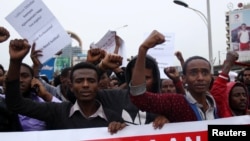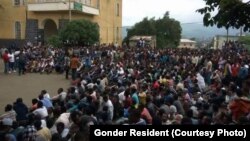The deadly protests that rocked Ethiopia in the past week stem from a diverse host of regional grievances but they reflect a shared sense of marginalization that may be bringing two of the country's largest ethnic groups together, analysts say, warning that there could be more unrest on the horizon.
Nearly 100 people were killed as security forces crushed the demonstrations over the weekend, according to opposition political parties and Amnesty International. Security forces opened fire on protesters, activists say.
The Ethiopian government blames the opposition in and outside the country for organizing what it calls "unauthorized protests by anti-peace forces." According to a statement by the government communications office, some protesters were carrying lethal weapons, including explosives. Opposition leaders deny the allegations, stating that the protesters were peaceful and unarmed.
The dispute in central Ethiopia dates back to November 2015. Demonstrators opposed a government plan to expand the municipal boundaries of the capital, Addis Ababa, into the Oromia Region. Farmers in the region were particularly upset, worrying that it could mean an end to their livelihood. The protests claimed the lives of more than 400 people, according to Human Rights Watch. Video showed security forces beating unarmed protesters and using live ammunition.
The government put the capital expansion on hold, and protests quieted down — but the grievance did not go away.
In early July, another wave of protests began, this time farther north in the city of Gonder, in the Amhara Region.
The main complaint by people in Amhara is that they want three districts — Welkait, Telemt and Tsegede — to be reintegrated into the Amhara Regional State, said Alemante Gebreselassie, professor of law emeritus at the College of William & Mary in the eastern U.S. state of Virginia.
Currently, the three districts are under the Tigray Regional State. Members of a group known as the Welkait committee also identify as ethnic Amhara and want to be part of the Amhara Region administration.
Negussu Tilahun, spokesperson of the Amhara Region, said these administration issues are cross-regional and the Amhara Region alone can't find answers.
"The Amhara Region cannot take ownership in trying to answer these questions because it will not find answers and it is not constitutional," he said in an interview with VOA Amharic Service.
If questions raised go beyond regional administration, he added, people should try to find answers through the federal court system.
Decades-old dispute in Gonder
Last month in Gonder, members of the Welkait committee were arrested. Residents took to the streets demanding their release, resulting in clashes with police and destruction of property.
The Welkait committee is demanding the reversal of the 1991 decision to place Welkait in the Tigray Region, said committee leader Colonel Demeke Zewdu, in an interview with VOA Tigrigna Service prior to his arrest.
"The people have been opposing this in different forms until now," he said. “Under the Tigray Region administration, the people didn't gain any benefits. Land has been taken away from them and they don't have socio-economic advantages. The society feels like it is regarded as second-class citizens."
Since the 15th century, the region known as Begemeder, which includes modern-day Gonder, had been autonomous and separate from the Tigray Region, said Gebreselassie.
Gebreselassie believes the move was an effort by Ethiopia's post-1991 leaders, who were from the minority Tigrayan ethnic group, to expand their homeland, an accusation echoed by protesters.
Oromia, Amhara solidarity
Decades of rivalry between the Oromo and Amhara may be giving way to solidarity, said Awol Allo, a fellow in human rights at the London School of Economics.
At rallies in the city of Bahir Dar, protesters were seen carrying signs that read "Stop Killing Oromo People" and "Free Bekele Gerba." Gerba is the deputy chairman of the Oromo Federalist Congress, an opposition party whose leaders are currently in prison.
Youth are key to this movement, Allo said. "[This is] a generation that would say it doesn't matter what force is used, I am determined to make my demands and to make my voice heard."
Ethiopia's Constitution states that regional borders can be redrawn.
“The constitution gives the basic rights of people for self-administration and where they can identify themselves as a home," said Soleyana S. Gebremichael, an Ethiopian lawyer and human rights advocate. “So the question of Welkait is directly related with that. People identify themselves as Amharas and they consider themselves as Amharas. They wanted to be administered by the region with their own language and promote their culture accordingly.”
Government response could intensify tension
The government has defended its use of the military and police force and restricted access to the internet, in particular social media.
“People have already learned how to go around that using proxies, using VPN. So the initial batch of videos came in using proxies and VPN. It seems to me that when authorities noticed that the information is still getting out that’s when they moved to shut down the entire internet," said Mohammed Ademo, a journalist with Al Jazeera and the editor of Opride.com, a news website that focuses on Oromo issues.
Organizers continue to work the old-fashioned way, by word of mouth, said Gebremichael.
"The organizing had been done at the grass-roots level, so with or without the internet,” she said. “People already had the urgency of going out to protest and then presenting their question and petitioning the government. That's what we saw in the past weekend because the internet was down for 48 hours and the protests happened anyway."















